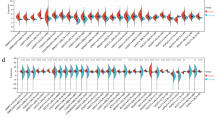Abstract
Background
CD44 is well known to be one of the cancer stem cell markers and is a cell-surface glycoprotein involved in cell–cell interactions, cell adhesion, and cell migration. We investigated the role of CD44 expression in both tumor and non-tumor tissues on recurrence of hepatocellular carcinoma (HCC).
Methods
Forty-eight patients with HCC who underwent hepatic resection at our institution were enrolled in this study. CD44 expressions in both tumor and non-tumor tissues were examined using real time reverse transcription-polymerase chain reaction. The patients were divided into two groups: high and low gene-expression group, based on the CD44 expression level. We compared the clinicopathological factors between the high expression and low expression groups in both tumor and non-tumor tissues.
Results
In the tumor tissues, the gene-expression levels of CD44 did not correlate with any clinicopathological parameters. The disease-free survival rate showed no significant difference between the two groups. In non-tumor tissues, although there was no significant relationship between the CD44 expression levels and clinicopathological factors, disease-free survival rate in the CD44 low expression group was significantly better than that in the CD44 high expression group (P < 0.05). In multivariate analysis, the risk factors in tumor recurrence were presence of microscopic portal invasion and high expression level of CD44.
Conclusion
The CD44 expressions in the non-tumor tissues may predict HCC recurrence.




Similar content being viewed by others
Abbreviations
- HCC:
-
Hepatocellular carcinoma
- RT-PCR:
-
Reverse transcription-polymerase chain reaction
- GAPDH:
-
Glyceraldehyde-3-phosphate dehydrogenase
- AST:
-
Aspartate aminotransferase
- ALT:
-
Alanine transaminase
- WBC:
-
White blood cell
- PT:
-
Prothrombin time
- ICGR15 :
-
Indocyanine green retention rate at 15 min
- AFP:
-
Alpha-fetoprotein
- DCP:
-
Des-gamma-carboxy prothrombin
References
Llovet JM, Beaugrand M (2003) Hepatocellular carcinoma: present status and future prospects. J Hepatol 38:S136–S149
Bruix J, Boix L, Sala M et al (2004) Focus on hepatocellular carcinoma. Cancer Cell 5:215–219
Lee JG, Kang CM, Park JS et al (2006) The actual five-year survival rate of hepatocellular carcinoma patients after curative resection. Yonsei Med J 47:105–112
Bendall LJ, Nillson SK, Khan NI et al (2004) Role of CD44 variant exon 6 in acute lymphoblastic leukemia: association with altered bone marrow localization and increased tumour burden. Leukemia 18:1308–1311
Ponta H, Sherman L, Herrlich PA (2003) CD44: from adhesion molecules to signaling regulators. Nat Rev Mol Cell Biol 4:33–45
Cooper DL, Dougherty GJ (1995) To metastasize or not? Selection of CD44 splice sites. Nat Med 1:635–637
Liu J, Jiang G (2006) CD44 and hematologic malignancies. Cell Mol Immunol 3:359–365
Naor D, Nedvetzki S, Golan I et al (2002) CD44 in cancer. Crit Rev Clin Lab Sci 39:527–579
Jin L, Hope K, Zhai Q et al (2006) Targeting of CD44 eradicates human acute myeloid leukemic stem cells. Nat Med 12:1167–1174
Leung EL, Fiscus RR, Tung JW et al (2010) Non-small cell lung cancer cells expressing CD44 are enriched for stem cell-like properties. PLoS ONE 5:e14062
Haraguchi N, Ohkuma M, Sakashita H et al (2008) CD133+ CD44+ population efficiently enriches colon cancer initiating cells. Ann Surg Oncol 15(10):2927–2933
Jothy S (2003) CD44 and its partners in metastasis. Clin Exp Metastasis 20:195–201
Seiter S, Schadendorf D, Herrmann K et al (1996) Expression of CD44 variant isoforms in malignant melanoma. Clin Cancer Res 2:447–456
Akisik E, Bavbek S, Dalay N (2002) CD44 variant exons in leukemia and lymphoma. Pathol Oncol Res 8:36–40
Endo K, Terada T (2000) Protein expression of CD44 (standard and variant isoforms) in hepatocellular carcinoma: relationships with tumor grade, clinicopathologic parameters, p53 expression, and patient survival. J Hepatol 32:78–84
Iizuka N, Oka M, Yamada-Okabe H et al (2003) Oligonucleotide microarray for prediction of early intrahepatic recurrence of hepatocellular carcinoma after curative resection. Lancet 361:923–929
Wang SM, Ooi LL, Hui KM (2007) Identification and validation of a novel gene signature associated with the recurrence of human hepatocellular carcinoma. Clin Cancer Res 13:6275–6283
Woo HG, Park ES, Cheon JH et al (2008) Gene expression-based recurrence prediction of hepatitis B virus-related human hepatocellular carcinoma. Clin Cancer Res 14:2056–2064
Poon RT, Fan ST, Ng IO et al (2000) Different risk factors and prognosis for early and late intrahepatic recurrence after resection of hepatocellular carcinoma. Cancer 89:500–507
Kumada T, Nakano S, Takeda I et al (1997) Patterns of recurrence after initial treatment in patients with small hepatocellular carcinoma. Hepatology 25:87–92
Utsunomiya T, Okamoto M, Wakiyama S et al (2006) Specific gene-expression profiles of noncancerous liver tissue predict the risk for multicentric occurrence of hepatocellular carcinoma in hepatitis C virus-positive patients. Ann Surg Oncol 13:947–954
Utsunomiya T, Shimada M, Imura S et al (2010) Molecular signatures of noncancerous liver tissue can predict the risk for late recurrence of hepatocellular carcinoma. J Gastroenterol 45:146–152
Kim HR, Wheeler MA, Wilson CM et al (2004) Hyaluronan facilitates invasion of colon carcinoma cells in vitro via interaction with CD44. Cancer Res 64(13):4569–4576
Zöller M (2011) CD44: can a cancer-initiating cell profit from an abundantly expressed molecule? Nat Rev Cancer 11(4):254–267
Marhaba R, Klingbeil P, Nuebel T et al (2008) CD44 and EpCAM: cancer-initiating cell markers. Curr Mol Med 8(8):784–804
Acknowledgments
This work was supported in part by Grants-in-Aid for Scientific Research (B) (20390359) and for Scientific Research (C) (22591506), and Grant-in-Aid for Challenging Exploratory Research (22659233 and 22659243), Japan Society for the Promotion of Science. This work was also supported in part by a grant from the Cancer Research Project Cooperated by TAIHO Pharmaceutical Co., LTD., and the University of Tokushima.
Conflict of interest
All authors declare that they have no conflict of interest.
Author information
Authors and Affiliations
Corresponding author
About this article
Cite this article
Tovuu, LO., Imura, S., Utsunomiya, T. et al. Role of CD44 expression in non-tumor tissue on intrahepatic recurrence of hepatocellular carcinoma. Int J Clin Oncol 18, 651–656 (2013). https://doi.org/10.1007/s10147-012-0432-6
Received:
Accepted:
Published:
Issue Date:
DOI: https://doi.org/10.1007/s10147-012-0432-6




